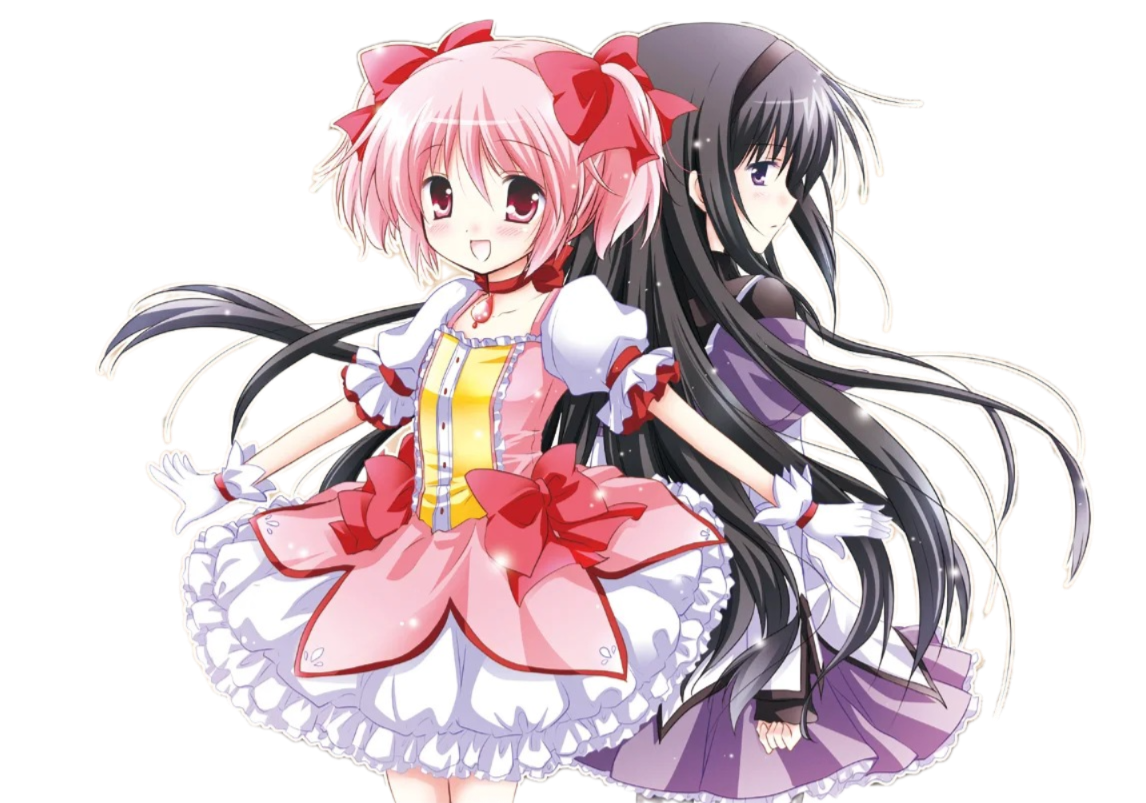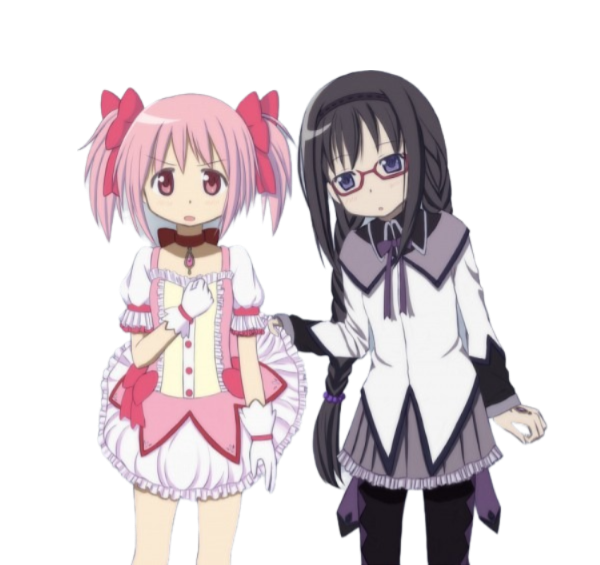







Madoka
Homura
very open
kind
cares about everyone
kind
cares about everyone
antisocial person
indifferent
strong
indifferent
strong
Multimodality, formed by combining "multi" and "modal," entails the use of various communication methods, including:
Linguistic: Written or spoken language.
Visual: Employing color, style, size, layout, and perspective.
Aural: Making use of music, sound effects, and tone of voice.
Gestural: Utilizing facial expressions and body language.
Spatial: Arranging elements within the scene.
In the examined scene from "Rebellion," all these modes seamlessly converge, crafting a diverse and engaging storytelling experience. ( Writer/Designer, ch. 1))
Linguistic: Written or spoken language.
Visual: Employing color, style, size, layout, and perspective.
Aural: Making use of music, sound effects, and tone of voice.
Gestural: Utilizing facial expressions and body language.
Spatial: Arranging elements within the scene.
In the examined scene from "Rebellion," all these modes seamlessly converge, crafting a diverse and engaging storytelling experience. ( Writer/Designer, ch. 1))

The genre that the author has opted to adopt and adhere to, as well as what the audience relies on to form their expectations. (Writer/Designer, ch. 3)
Rhetorical Analysis is a method used to scrutinize a text by discerning the following aspects:
Audience: Identifying the target group the author aims to engage or communicate with.
Purpose: Recognizing what and why the author is conveying specific messages to the audience.
Context: Understanding the conditions and circumstances in which the author communicates the intended message or call to action, including when and where.
Writing and Designing Decisions: Analyzing the choices the author makes in crafting the text, taking into account the identified audience, purpose, and contextual factors, and examining how these decisions contribute to the overall effectiveness of the communication. (Writer/Designer, ch. 2)
Audience: Identifying the target group the author aims to engage or communicate with.
Purpose: Recognizing what and why the author is conveying specific messages to the audience.
Context: Understanding the conditions and circumstances in which the author communicates the intended message or call to action, including when and where.
Writing and Designing Decisions: Analyzing the choices the author makes in crafting the text, taking into account the identified audience, purpose, and contextual factors, and examining how these decisions contribute to the overall effectiveness of the communication. (Writer/Designer, ch. 2)



"Puella Magi Madoka Magica" is a captivating and straightforward anime that provides ample material for both rhetorical and visual analysis. This Japanese anime series stands out as an innovative and deconstructive take on the traditional "sorceress" or magical girl genre. Helmed by director Akiyuki Shinbo and written by Gen Urobuchi, the series made its debut in 2011, leaving a lasting impression as my inaugural anime experience. Though I've chosen just one excerpt for analysis, let's first delve into a bit of background information to ensure a clear and accessible understanding of the context.
WATCH THE MOVIE
Watch the moment between 1:21:00 and 1:26:00
Madoka Kaname, an average middle school student, becomes the main character in this story. When the mysterious Kyubey offers her the chance to transform into a magical girl, her entire world changes dramatically. Though the plot initially seems to follow the traditional magical girl cliché, it really delves into a dark and intricate examination of issues like sacrifice, morality, and the ramifications of possessing great talents. The series has cemented its status as a notable entry in the anime scene with its ability to flout genre expectations and its distinct visual style, which was brought to life by the animation studio Shaft.
Keeping this context in mind, let's now focus on the chosen excerpt for an in-depth look.
Keeping this context in mind, let's now focus on the chosen excerpt for an in-depth look.
The intended audience : People who watched the entire movie, especially in the last few minutes, and people who watched the entire TV series.
The Secondary audience: People who have seen "Madoka Magica" before and are thinking about seeing it; they might base their decision on internet reviews.
The unintended audience : People on social media who come across re-uploads of animation sequences, people who go to movies but don't know they're sequels, and professors and teachers who come across their students' blog entries.
The Secondary audience: People who have seen "Madoka Magica" before and are thinking about seeing it; they might base their decision on internet reviews.
The unintended audience : People on social media who come across re-uploads of animation sequences, people who go to movies but don't know they're sequels, and professors and teachers who come across their students' blog entries.
The first scene Homura's imagined vision, and the second scene which is where witches are formed. Homura makes the decision to finish her transformation into a witch after learning that Kyubey has imprisoned her and Madoka in an isolation field. The decision to sacrifice her to magical girls is meant to break Madoka's isolation field and set her free.
This scene from "Puella Magi Madoka Magica" aims to show how hopeless Homura becomes and how hopeless her attempts to save Madoka are. It represents the emotional and narrative depth of the series while acting as a visual investigation of Homura's character, particularly in light of her transformation into a witch.
Animation is a key component of the original series, the film that follows it, and the scene in question since it allows for artistic freedom to produce expressive visual effects. "Magical girls" was the original definition of the primary film's genre, but as the story developed, the writers destroyed the genre's traditional tropes to create something more in line with a psychological thriller or horror. The dynamics of the genre, which go from psychological horror to surrealism, are particularly evident in this episode.
The main goals of the episode are to portray Homura's inner agony and to examine her relationship with the creators, which is a reflection of her desperation.
The creative style is notable for its deliberate divergence to accentuate the imaginative and terrifying character of the magical realms, particularly in the chair and maze scenes.
Bright colors are used in the chair scene to create a dreamlike effect, while muted dark tones with a splash of crimson are used in the Nutcracker Witch Labyrinths to create a nightmare-like feeling.
In terms of organization, the first scene—which features Homura and Madoka on a straightforward field—is clear, while the second scene—which features a chaotic, intricate labyrinth that adds complexity—is chaotic.
The creative style is notable for its deliberate divergence to accentuate the imaginative and terrifying character of the magical realms, particularly in the chair and maze scenes.
Bright colors are used in the chair scene to create a dreamlike effect, while muted dark tones with a splash of crimson are used in the Nutcracker Witch Labyrinths to create a nightmare-like feeling.
In terms of organization, the first scene—which features Homura and Madoka on a straightforward field—is clear, while the second scene—which features a chaotic, intricate labyrinth that adds complexity—is chaotic.




Iconography is a branch of art history that studies works of visual art on three levels: Primary, conventional (using conventions and prior knowledge), and Intrinsic level (a deeper look at hidden topics).
(Visual Culture, ch. 1)
(Visual Culture, ch. 1)
PRIMARY LEVEL

Homura glances about her as if she had just woken up, showing surprise, as you can see in the first level of the description. In the field, Madoka is seated next to her on a chair. Then, with a smile for Homura, Madoka stands up, lifts her arms, and begins to descend. Homura approaches her in an attempt to capture her, but she appears differently and is unable to seize Madoka. Madoka becomes a patch of pink grass. Dark Homura-esque entities emerge, their faces expressionless as they gaze down from above. A sudden appearance of an even larger version of herself, kneeling beside enormous chairs, destroys the wailing, kneeling Homura.

CONVENTIONAL LEVEL
At first, Homura and Madoka sit in a vivid environment with lots of vegetation, but this is all in Homura's head. When Madoka falls, strange things happen that alter Homura's look. In an attempt to save Madoka, Homura becomes unrecognizable, mirroring her own life's trajectory. When Madoka hits the ground, her pink paint is symbolically splattered, and when Homura is destroyed, her purple paint is splattered. Homura's emotional fluctuations show an internal struggle.

This image seemed to capture Homura's deepest desire—to spend some alone time with Madoka in a beautiful place. But the delusion disintegrates as Madoka appears to offer a sacrifice while perched on a chair. Madoka appears unsure about her choice before collapsing. The enormous figures surrounding Homura from earlier incarnations of herself can voice disapproval as Madoka transforms into a pink mess. The enormous Homura that crashed represents her desperate attempts to save Madoka. When left on her own, Homura comes to terms with the pointlessness of her attempts and comes upon enormous chairs, which could represent her realization that the ideal world is unachievable. She sobs in this harsh reality, focusing only on Madoka and stating that Madoka was her one and only reason in life.
INTRINSIC LEVEL
CONNOTATIONS
The hat worn by Homuli, which has the appearance of a record player, represents the never-ending recurrence of the events that Homura goes through while fighting for Madoka. Gamal's loss of herself, symbolized by the splitting of Ili's head, represents her loss of sanity in her attempt to save Madoka. The sight of Madoka behind locked doors and the shattered record player signify the end of Homura's never-ending quest to alter history. The witch named "The Nutcracker" may allude to Homuli's impotence in the absence of Madoka, as her lack of a face highlights how dependent on her for survival. Homura's wish to build an ideal world is highlighted by visual themes like the ribbon and the Nutcracker, which enhance comparisons with Hoffmann's The Nutcracker and the Mouse King narrative.

ICON
Following this moment, we witness a purple salamander cry and transform into a purple jumble, resembling Homura's previous surreal image. "Homura" means "flame" in Japanese, and salamanders, being connected to fire and capable of withstanding it, symbolize Homura herself.
SYMBOL

These animals also represent rebirth, vigor, and desire. The red spider flowers and salamander highlight the movie's prediction of later scenes, while Homura's mental state is reflected in the falling teeth, which stand for worry, issues with self-worth, and a fear of change. Even though it is subdued, the rainbow-colored sky might be Homura's final attempt to maintain optimism or pretend that a bright future is coming. Additionally, the rainbow might contain LGBTQIA+ symbolism, which would imply a romantic love between Homura and Madoka that is implied in anime

INDEX
Homura turns against the other key characters in the indexing events sequence, save for the visual countdown to the Homily's completion and the raising of the crimson curtain. Everything is in disarray, things arise out of nowhere, and geometry and physical rules are warped. Even if everything seems disorganized, everything has a purpose, and you can figure it out by looking at the visual story of the first TV show.

RHYTHM OF LINES
When examining the image with the chair more closely, the background and objects appear blurry, which adds to the setting's uneasiness. The dizzying mood in Homuli's maze is created by the twisted rhythm of the lines, which mirrors Homura's depressing mental state.
Both visual and emotive design aspects are used in the form. Space represents size and proportions, Light and Shade convey feelings about objects through the precise distribution of the light source, color directly expresses emotions using a variety of color palettes, and the rhythm of the lines defines objects, conveying the author's feelings.
(Visual Culture, ch. 2)
(Visual Culture, ch. 2)
MASS
The sequence opens with the objects shown realistically, but the sense of reality vanishes when Madoka transforms into a pink mass. The second Homuli has a twisted jumble of things that throws off proportions and creates an unsettling feeling. Gamali emphasizes the environment's volatility by appearing to have varying weights in different scenes.
SPACE
The landscape is wide and open at first, but once Madoka falls, it gets smaller and more crowded with close-up shots of the things. This could represent Homura's perception that, in Madoka's absence, the world is growing smaller.
The second scene in Homuli is replete with details that highlight Homura's pessimism and give the viewer a sense of claustrophobia. Her problem is highlighted by the confusing appearance and absence of open regions.
The second scene in Homuli is replete with details that highlight Homura's pessimism and give the viewer a sense of claustrophobia. Her problem is highlighted by the confusing appearance and absence of open regions.
DANA
A feeling of peace is evoked by the hues of the first scene and natural light. A rainbow sky and dark, stunning colors create a bizarre environment in the second Homulilli. Yoke's feelings are reflected in these hue shifts, which also enhance the visual story.
Natural lighting in the opening scene gives the characters a realistic appearance against an overexposed background, giving the scenario a strange vibe.
Even in the night maze in the second scene, the lack of light and shadow highlights abstraction. The spectator is confused and given a stronger sense of unreality by the mosaic effect.
Natural lighting in the opening scene gives the characters a realistic appearance against an overexposed background, giving the scenario a strange vibe.
Even in the night maze in the second scene, the lack of light and shadow highlights abstraction. The spectator is confused and given a stronger sense of unreality by the mosaic effect.

